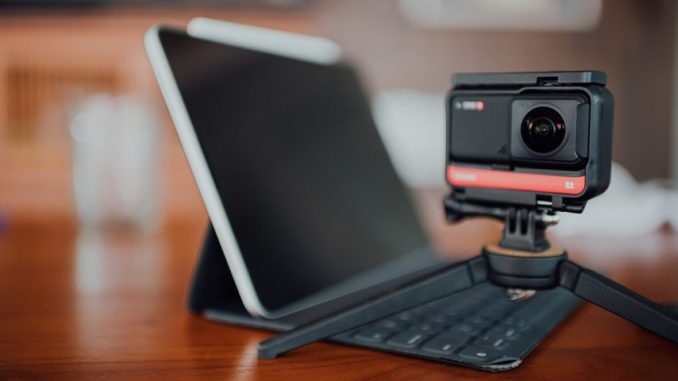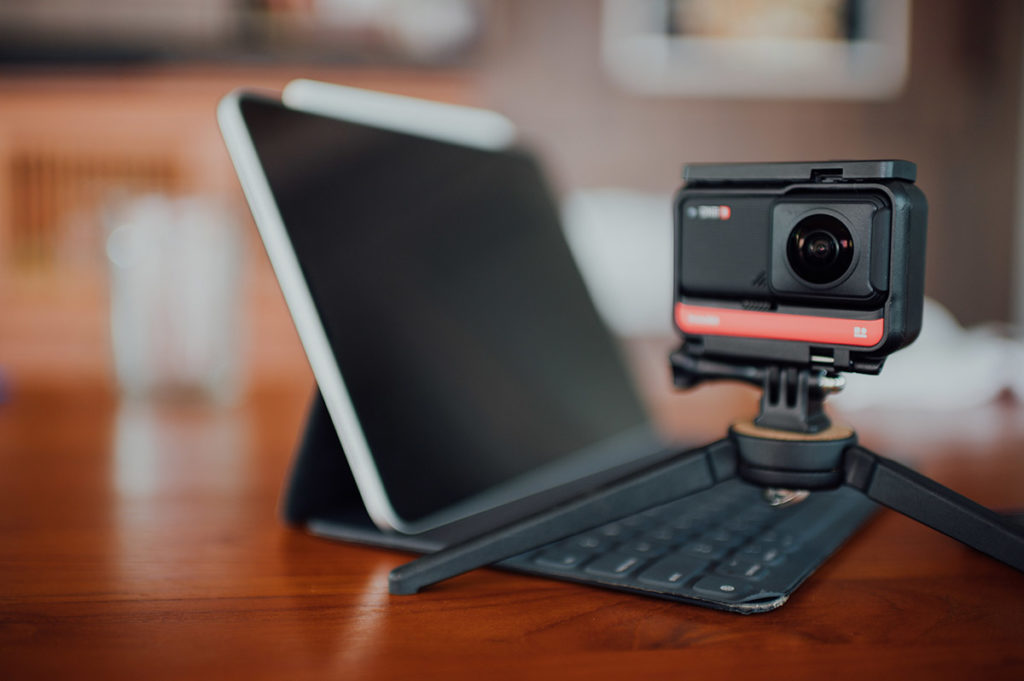
How to Setup the Perfect Space at Home for your DIY Social Media Videos

Creating videos to demonstrate just about anything is the expectation now. Whether you’re an influencer looking to build your brand, income, and audience with engaging videos or a teacher who is remotely creating educational content for students, one thing is for sure: Creating high-quality video content for communications is more important than ever.
Creating a basic video streaming or filming setup doesn’t need to be complicated or expensive — although it certainly can be. Setting up an efficient DIY space at home for shooting videos that include sets, lighting, sound, and editing software can be achieved quickly and inexpensively if you’re crafty about it.
In This Content
WHAT TO CONSIDER BEFORE JUMPING IN
When you’re planning your home video setup, keep these things in mind.
Your budget. What is your budget for your video studio, equipment, and software? While you can definitely get creative on a small budget and make a professional impact for around $100, the quality of your lighting, camera, and editing software does matter. These elements make a huge difference in the finished look. Weigh out the cost of various options, keeping in mind your skill level and your space at home.
Space. How much space are you willing to commit to filming your videos and editing them? If you have a dedicated spare room for a studio, that’s best, but you can also transform a corner of a room into a video production area if you’re willing to part with the space.
The return/results. What are you hoping to get out of your video productions? More customers or clients? More income? Or is this a hobby project? Spend and commit to a space accordingly.
Video style. Are you vlogging and speaking directly to the camera? Will you be demonstrating an activity that needs a certain viewpoint, such as cooking in the kitchen, gardening outdoors, yoga in a studio, or building in a workshop? Do you need props or special equipment? The setup you are creating for your videos needs to make sense for the project. Before you plan out what you need for video gear, (set, lighting, and editing, etc.,) decide on the best scenario for you and your video production.
EQUIPMENT REQUIRED FOR YOUR SOCIAL MEDIA VIDEOS
One of the reasons why video is such a popular method of creating content is because literally, anyone with a smartphone can do it. In theory, you can shoot an effective social media video or online class with no more than a phone, an app, and an internet connection.
In reality, though, educational, engaging, and entertaining video content creation is more successful when it is more planned out and curated. A good place to start upgrading for better quality in video and sound is with your recording equipment.
The Camera
A smartphone is an easy and popular choice for recording videos. If you have one, you can pretty much achieve any basic type of video for social media or instruction. Even if you choose a video camera or DSLR for your video recording, having a smartphone on a tripod for a second camera view is an excellent way to maximize your video studio options
Using a DSLR camera in video mode offers great video quality. Try out different lenses for cinematic quality: A 50mm lens will provide a view that is well-designed for waist-up shooting, while a wide angle lens, like a 35mm lens, can make up for the lack of space in the room.
You’ll need a tripod for your smartphone or DSLR. Consider using a clamp-on, “mount anywhere” design, which offers flexibility and the ability to change the position of the camera easily.
The Sound
External microphones are best for filming high quality videos. A camera’s built in microphone has limited capabilities and can decrease the overall quality of your video.
Depending on the setup of your studio, here are a few microphone options to consider:
A USB desktop or clamp-on, adjustable microphone arm is an excellent option if you are speaking directly to the camera and your head and shoulders won’t be moving around too much while you’re filming. You may want to consider a pop filter for your desktop microphone to eliminate the POP sounds in your speech.
A lavalier microphone (wired or bluetooth) is an excellent option if you are demonstrating while standing or moving around.
Sound treatments. If your filming room is echoey or noisy, add carpeting, blankets, or professional sound panels to the floors and/or walls to muffle external sounds.
The Lighting
Video lighting professionals use a 3 point lighting technique which includes a:
- Key light for primary illumination
- Fill light opposite the primary light to fill in shadows.
- Background light to add three-dimensionality.
Other elements that will help improve lighting include:
- A light box, which will diffuse the light and maximize overall scene brightness
- The angle of the light
- The type of bulbs you use in the fixtures to create brighter or dimmer light
- Blocking out natural daylight and using artificial lights only
- Using strip lights on low ceilings where lamps are not possible
- Halo lamps for up-close, primary light in small spaces
- Natural light — it’s free and easy!
Editing Technology
If you are editing your videos yourself, evaluate what paid and free software is available for your equipment — Windows, Mac, iPhone, or Android. From free apps on your phone to more expensive software that you use on your computer, finding the editing solution that works best for your needs, budget, and skill level will help ensure success. If you’re new to editing, start small and simple, and upgrade as you learn what you need and want in an editor. Depending on your skill level and tools, it’s easy to find options for the right fit.
THE BEST PLACES FOR A VIDEO SETUP AT HOME
When you are choosing your studio space, here some things to consider:
- Is it practical to convert this space?
- Is the lighting adequate? The sound? The accessibility?
- Can I store equipment here easily?
- Will I need a remote setup for some scenes?
- Is it easy to tear down equipment and set it back up?
If you’re making a cooking show, you’ll obviously need to set your kitchen up for filming — same thing if you’re doing a gardening show outdoors. Clean out a spare bedroom, basement storage room, or even a shed or garage that you can convert into your studio. If you’re on a tight space budget, carve out a little corner of space in one of your existing rooms — you may need to do a little rearranging, but you’ll be surprised how much you can do with a small space. For example, in a corner of the living room, hang a backdrop — a tapestry, a blanket, a sheet — to create the impression of dedicated space. Adequately lighting your small space will go a long way toward making it look professional. Whether you have a large or small studio space, make sure the surrounding scenery isn’t distracting, and keep your area organized.
TIPS FOR PLANNING EXCEPTIONAL VIDEO CONTENT
You can have all of the tools, but without a plan, your content will lack structure, cohesiveness, and development. Planning is paramount when it comes to great videos.
- Create a content calendar to set up in advance what video topics you want to cover in your series.
- Create storyboards to plan out each video from intro to outro with a Storyboard Template
- Create social media posts and stories using clips from your video to promote your content.
- Check out trends from other video influencers and brands you enjoy.
Other ways to expand your reach using video content production:
- Encourage your viewers to like and subscribe. Social media is meant to be social! Ask for feedback, and give your viewers a call to action, such as following you or opting in to your email list.
- Engage with subscribers. When they comment, reply!
- Collaborate with other influencers. Expand your reach by partnering with another video influencer or online expert.
- Teach a class online to engage new viewers and expand your audience.
You don’t need expensive tools or equipment to make great videos. With some planning, a little creativity, and a bit of craftiness and know-how, you can create professional-looking and engaging videos for any audience, on any platform. The whole point of video content is that it is a straightforward, quick, and easy way to convey information and educate your audience — yet it’s incredibly flexible and invites creativity. With the right camera, sound, lighting, and tools, creating videos to grow your audience is easy and fun.
[“source=webpurify]
